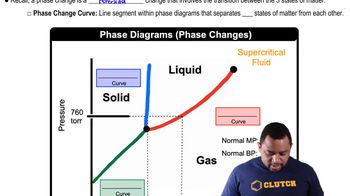Here are the essential concepts you must grasp in order to answer the question correctly.
Vapor Pressure
Vapor pressure is the pressure exerted by a vapor in equilibrium with its liquid or solid phase at a given temperature. It indicates the tendency of a substance to evaporate; higher vapor pressure means a greater tendency to vaporize. In this context, the vapor pressure of CCl3F at 300 K is 856 torr, which serves as a critical threshold for determining whether liquid will remain in the container.
Recommended video:
Raoult's Law and Vapor Pressure
Ideal Gas Law
The Ideal Gas Law relates the pressure, volume, temperature, and number of moles of a gas through the equation PV = nRT. This law helps in calculating the number of moles of CCl3F present in the container, which is essential for comparing it to the vapor pressure. Understanding this relationship allows us to determine if the conditions favor the presence of liquid or if all the substance will be in the gaseous state.
Recommended video:
Phase Equilibrium
Phase equilibrium occurs when the rates of evaporation and condensation of a substance are equal, resulting in a stable mixture of liquid and vapor. In this scenario, if the number of moles of CCl3F exceeds what can exist as vapor at the given vapor pressure, some of it will remain as liquid. Analyzing the mass of CCl3F and its vapor pressure helps in assessing whether liquid will be present in the container.
Recommended video:
Phase Changes in Diagrams
 Verified step by step guidance
Verified step by step guidance


